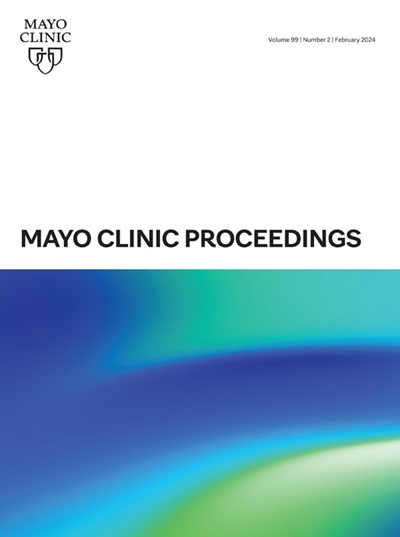2型糖尿病、高血压和血脂异常家族史及其患病率和发病率的横断面和纵向关联:Toranomon医院健康管理中心研究(TOPICS24)。
IF 6.7
2区 医学
Q1 MEDICINE, GENERAL & INTERNAL
引用次数: 0
摘要
目的:探讨2型糖尿病(T2DM)、高血压和血脂异常的阳性家族史(父母、兄弟姐妹和祖父母)与其在同一人群中的患病率和发病率的关系。患者和方法:对1997年1月1日至2007年12月31日期间接受健康检查的41,361名参与者的数据进行了分析,并对同一队列的logistic和Cox回归分析结果进行了检验。结果:横断面分析显示,所有三种疾病的患病率都随着阳性家族史的增加而增加,尤其是T2DM,当患病亲属数大于或等于3时,比值比(OR)为12.00 (95% CI, 7.82至18.41),与无家族史相比,三代阳性家族史的OR为20.43 (95% CI, 11.0至37.8)。然而,将家族史从“父母、兄弟姐妹和祖父母”重新定义为“父母和兄弟姐妹”或“仅父母”并没有显著改变每种疾病的or。在阳性家族史和体重指数大于或等于30.0 kg/m2的人群中,高血压患病率是无家族史和体重指数18.5 ~ 24.9 kg/m2人群的19倍。在纵向研究中,家族史强烈影响T2DM的发生(危险比[HR], 2.40;95% CI, 1.93 ~ 2.98),高血压(HR, 1.43;95% CI, 1.26 ~ 1.62)和血脂异常(HR, 1.41;95% CI, 1.08 ~ 1.83)。结论:获得这些疾病的家族史有助于确定高危人群。此外,对于2型糖尿病,阳性家族史的影响是最强的,随着患病家庭成员的重叠,患病风险显著增加,这表明家族史对早期发现和预防是有用的。本文章由计算机程序翻译,如有差异,请以英文原文为准。
Cross-sectional and Longitudinal Associations Between Family History of Type 2 Diabetes Mellitus, Hypertension, and Dyslipidemia and Their Prevalence and Incidence
Objective
To examine the association between a positive family history (parents, siblings, and grandparents) of type 2 diabetes mellitus (T2DM), hypertension, and dyslipidemia and their prevalence and incidence in the same population.
Patients and Methods
Data on 41,361 participants who underwent health examinations between January 1, 1997, and December 31, 2007, were analyzed, and the results of logistic and Cox regression analyses in the same cohort were examined.
Results
Cross-sectional analyses showed that the prevalence of all three diseases increased with a positive family history, especially T2DM, with an odds ratio (OR) of 12.00 (95% CI, 7.82 to 18.41) when the number of affected relatives was greater than or equal to 3 with an OR of 20.43 (95% CI, 11.0 to 37.8) for a positive family history across three generations compared with no family history. However, redefining family history from "parents, siblings, and grandparents" to "parents and siblings" or "parents only" did not significantly change ORs for each disease. Among those with a positive family history and body mass index greater than or equal to 30.0 kg/m2 hypertension was 19 times more prevalent compared with no family history and body mass index of 18.5 to 24.9 kg/m2. In the longitudinal study, family history strongly influenced incident T2DM (hazard ratio[HR], 2.40; 95% CI, 1.93 to 2.98), hypertension (HR, 1.43; 95% CI, 1.26 to 1.62), and dyslipidemia (HR, 1.41; 95% CI, 1.08 to 1.83), respectively.
Conclusion
Obtaining a family history of these diseases was useful in identifying high-risk groups. Also, for T2DM, the influence of a positive family history was strongest with a marked increase in risk with overlap of affected family members, suggesting that a family history is useful for early detection and prevention.
求助全文
通过发布文献求助,成功后即可免费获取论文全文。
去求助
来源期刊

Mayo Clinic proceedings
医学-医学:内科
CiteScore
16.80
自引率
1.10%
发文量
383
审稿时长
37 days
期刊介绍:
Mayo Clinic Proceedings is a premier peer-reviewed clinical journal in general medicine. Sponsored by Mayo Clinic, it is one of the most widely read and highly cited scientific publications for physicians. Since 1926, Mayo Clinic Proceedings has continuously published articles that focus on clinical medicine and support the professional and educational needs of its readers. The journal welcomes submissions from authors worldwide and includes Nobel-prize-winning research in its content. With an Impact Factor of 8.9, Mayo Clinic Proceedings is ranked #20 out of 167 journals in the Medicine, General and Internal category, placing it in the top 12% of these journals. It invites manuscripts on clinical and laboratory medicine, health care policy and economics, medical education and ethics, and related topics.
 求助内容:
求助内容: 应助结果提醒方式:
应助结果提醒方式:


